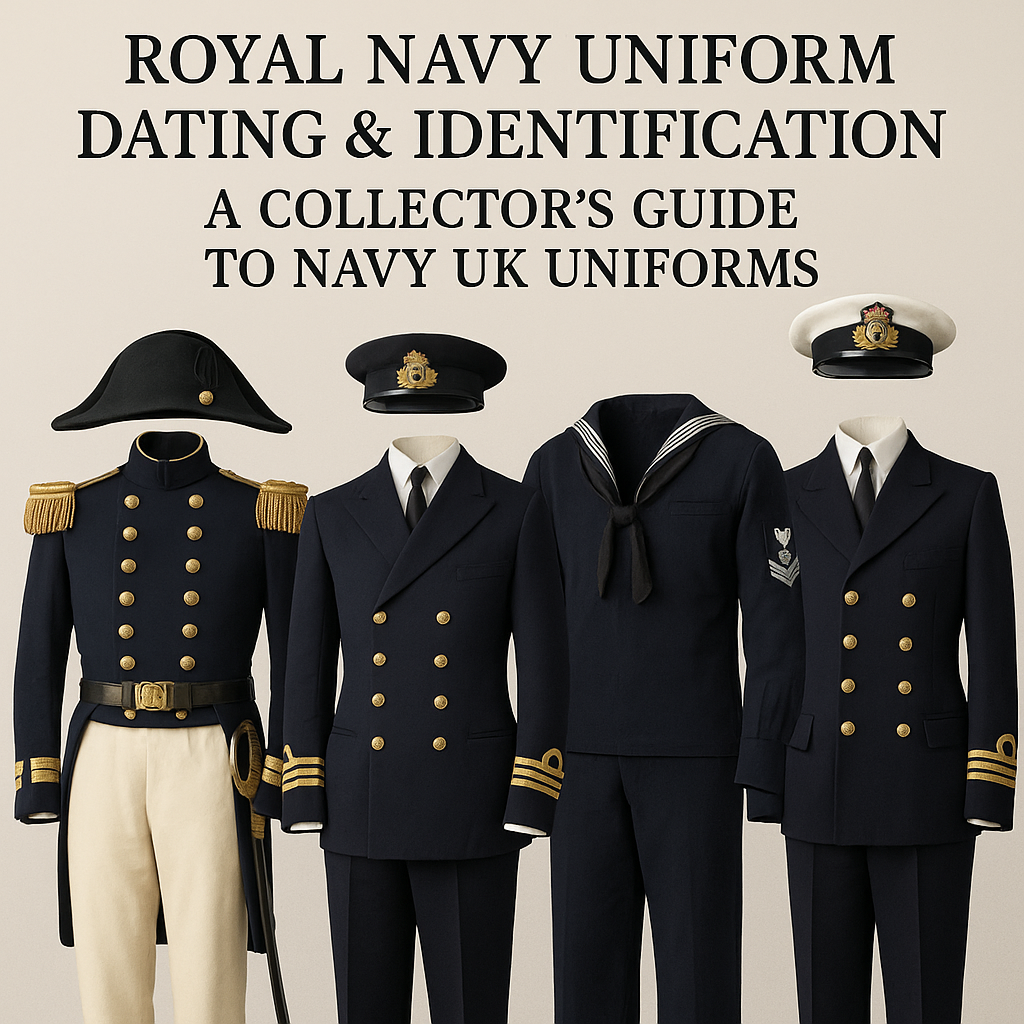
Royal Navy Uniform Dating & Identification: A Collector’s Guide to Navy UK Uniforms
Published on May 16, 2025
Royal Navy Uniform Dating & Identification: A Collector’s Guide
The Royal Navy has long stood as a symbol of Britain’s maritime dominance. From the Napoleonic Wars to World War II and beyond, its uniforms have evolved in tandem with naval history. However, to collectors and history enthusiasts, the finer details of navy UK uniforms offer more than just aesthetic appeal—they provide insight into specific eras, ranks, and individual service records.
Whether you’re restoring a historic piece, building a reenactment kit, or collecting Royal Navy artifacts, understanding how to date and identify these uniforms is essential. This guide breaks down key identification tips, uniform evolution, and what to look for in navy officer uniforms from the 1800s to today.
A Brief History of Royal Navy Uniforms
Origins and the 18th Century Foundations
The first standardized Royal Navy uniforms were introduced in 1748. Officers received blue coats with white facings—a color scheme that remains iconic. Before this, sailors wore whatever they could find, often a mix of civilian and military garments.
As naval warfare professionalized, so did the attire. Uniforms became not just about appearance but about signaling rank, role, and order within the ship.
Key Eras in Navy UK Uniform Evolution
1800–1857: Napoleonic Wars and the Georgian Era
This period saw the refinement of naval uniforms, especially for officers. Common identifiers included:
- Double-breasted coats with gold lace trim
- High collars and epaulets (introduced in 1795)
- Bicorn hats are worn fore-and-aft or side-to-side, depending on personal preference
- Royal coat of arms buttons with crown and anchor motifs
Uniforms from this era were bespoke, often tailored by London's finest military clothiers.
1857–1891: Victorian Influence
The 1857 regulations brought consistency across the board. Uniform changes included:
- New rank lace system (using stripes on cuffs)
- Introduction of rank shoulder boards and branch insignia
- Emergence of undress uniforms for daily duties
Victorian-era naval uniforms are among the most ornate and are sought-after by collectors for their detailed gold braid and craftsmanship.
Early 20th Century: Edwardian to World Wars
1900–1914: Pre-WWI Changes
The early 1900s introduced further standardization, particularly in naval officer uniforms. Innovations included:
- Stiff-collar white tunics for tropical stations
- Sword belts and dirks are used ceremonially
- Trousers with gold side stripes for officers
1914–1945: World Wars I & II
The demands of war shaped uniforms into more functional designs:
- Service dress blues became standard
- Introduction of rating badges on sleeves
- More durable worsted wool for seafaring conditions
WWII-era uniforms were mass-produced, yet certain tailoring cues (e.g., hand-finished cuffs) helped distinguish officer wear from enlisted garments.
Post-War to Modern Day: 1945–Present
In the post-war period, ceremonial dress retained tradition, but working uniforms adapted to modern needs:
- No. 1 Dress (Ceremonial Blue) remains the most recognizable today
- Combat dress and action working dress introduced for practical duties
- Women’s naval uniforms were officially standardized in 1970
Today’s Royal Navy uniforms still carry traditional elements like rank lace and peaked caps, yet are now designed for functionality, safety, and inclusion.
How to Date Royal Navy Uniforms
1. Check Rank Insignia
- Pre-1856: Rank shown via epaulets and buttons
- Post-1856: Look for rank lace on sleeves
- A single thin stripe = Sub-lieutenant
- Thick stripe with thinner ones above/below = Commander/Captain
2. Study the Buttons
Buttons can be a giveaway for the period:
- Pre-1840s: Raised crown and anchor with fine detailing
- Victorian: Stamped "Fouled Anchor" with a rope wrap
- WWII-era: Often stamped with “Gaunt London” or “Smith & Wright”
3. Look Inside for Tailor Labels
Many historic uniforms have inner labels from military tailors:
- "Gieves & Hawkes" or "Hobson & Sons" can help pinpoint the era
- Check handwritten names or service numbers
4. Examine Construction and Material
- Wool weight: Heavier in earlier uniforms
- Hand stitching: Suggests pre-1900s or officer-only wear
- Machine stitching: Typically post-WWI and for mass issue
Common Features of Navy Officer Uniforms
Officer uniforms differ from enlisted wear in both quality and detail:
- Gold braid (lace) on cuffs and epaulets
- Sword belts, often with lion-head buckles
- Cap badges that include royal crowns and anchors
- Tailcoats in ceremonial settings (especially 1800s)
Understanding these cues helps determine whether a uniform belonged to an officer and what rank or branch they served in.
Where to Find and Collect Royal Navy Uniforms
Whether you're starting a collection or expanding it, authentic Royal Navy pieces can be found through:
- Specialist militaria dealers (like Paddelaters)
- Estate sales or auctions of military families
- Online marketplaces—be cautious of reproductions
- Military surplus stores, especially in the UK
Royal Navy Uniforms in Reenactments and Museums
Today, collectors, museums, and historical reenactors keep these traditions alive. From Trafalgar Day events to WWII commemoration parades, historically accurate uniforms add depth to storytelling and public history.
If you're building a display or reenactment impression, ensure:
- Rank and era match your narrative
- Insignia and badges are accurate for the period
- All elements—from hat to boots—are appropriate in style and materials
Conclusion: Preserving Naval History Through Uniforms
WW1 Royal uniforms are more than just garments—they're threads of history woven with tales of valor, exploration, and tradition. Learning how to date and identify these pieces gives collectors and enthusiasts a deeper appreciation of their heritage.
